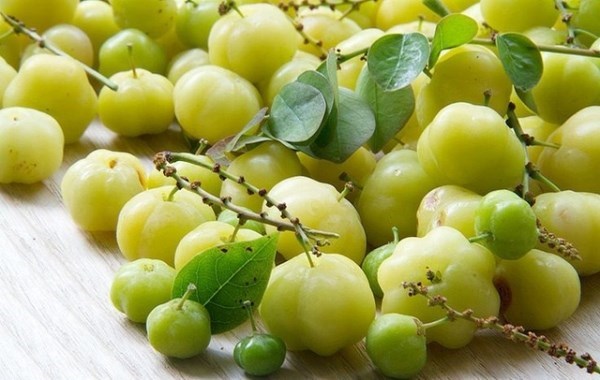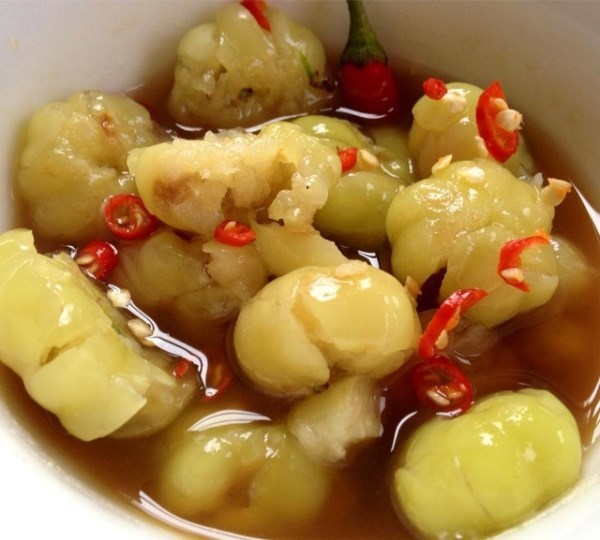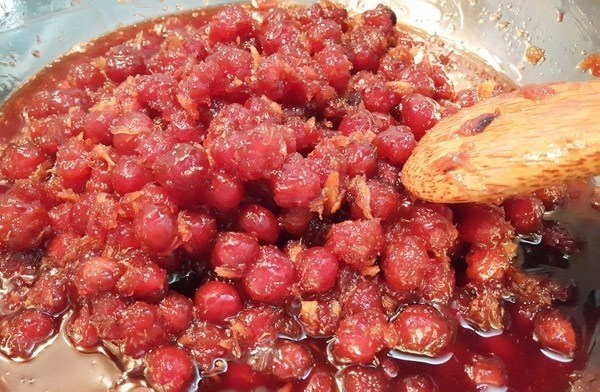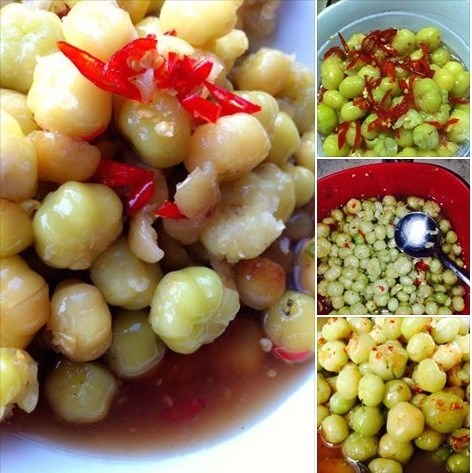Star-berries
(or country gooseberry, Malaysian gooseberry – scientific name Phyllanthus
acidus) is a tall tree (5 – 6m), suitable in tropical zone and almost
ubiquitous in the Mekong Delta area. The leaf is a double leaf, about 4 -5 cm
long with a blue on the upper side and gray on the underside. Star-berry tree
flowers from December and its fruit get ripen around June to August.

Star-berries recall childhood.
Picking
star-berries from the trees is one of the most interesting games of countryside
kids. Indeed, that’s a tough game. Kids have to assign specific tasks, such as
who smaller yet skillful kids climb up the trees and shakes while others spread
a sheet out to catch dropping fruits.
Ripe
star-berry fruit is yellowish and just as big as a knuckle. There are 2 types
of star-berry fruits: sweet and sour. While sweet ones will be eaten raw, sour
fruits are used to make fruit candies, spices, or fruity wine. People also use
star-berry young leaves as side vegetables or to roll sour pork, especially in
some areas of central Viet Nam.
The
most memorable dish from star-berries is star-berry and climbing perch fish
sour soup from the southwest. This soup is really similar to traditional one
but instead of tamarind or other sour produce, they use star-berries. Boiling
water, putting smashed star-berries into the season with salt and sugar to
taste. Fish should be rare cooked then the rest ingredients as okras, tomatoes,
sawah lettuce (Limnocharis flava), and herbs. The dish would not be completed
without pure fish sauce and couples slices of hot chili.

Star-berries in fish sauce makes a great taste.
Diners
take a piece of fish and dip in fish sauce, slowly chew, and feel all flavors
and texture of wild caught rural fish. Pour sour soup into your rice bowl as a
real southwest local, you’ll recognize the unique transparently sour taste of
star-berries.
Old
people tend to favor star-berry wine. It’s simple and affordable. Washing sour
star-berries and draining them out then layer them with white sugar in a big
glass jar; keep the jar under sunlight to fasten fermenting process. After 2
weeks, sugar and star-berry juice really blend in and we just collect the
liquid.
For
children and women, sweetened star-berries are irresistible. However, this
snack requires much time and care.
People
choose all mature fruits, wash, and lightly smash them between two heavy
surfaces so that the sour juice should come out. However, if smashing too hard,
the fruits will be damaged and the final product can’t be nice looking. Next,
they wash smashed fruits several times in clean water in order to take more
sour juice out and the fruits become more sugar-absorbable.

Delicious and irresistible sweeten star-berries.
Traditionally,
this is how people make sweeten star-berries: seasoning prepared star-berries
with white sugar and a pinch of red syrup for nicer color; heat the whole
mixture on low fire; stirring by chopsticks until sugar liquid gets really
thick and sticky.
How
joyful when we can treat ourselves this sweet in summer! Usually people use a
short tiny stick (as a toothpick) to pick a sweetened fruit so hands will not
get sticky. Just slowly chewing and taste all flavors, from sugar’ sweetness to
star-berry’s sourness, the dish is more delicious even than its look. To make
different versions, we can add some slices of smashed fresh ginger, some
kumquats, lime juice, fresh or powder chili, or cinnamon into the mixture
during heating process.
Star-berries
are not available year round so that we can only have fresh fruits within
summer. To balance that shortage, star-berries are very easy to be processed
into various dishes.

Star-berries can be processed into various dishes.
According
to traditional medicine, fruits, leaves, rind, and roots of star-berry all have
medical effects. Its fruits carry cooling effect so it’s good for liver, blood,
and skin; bathing with boiling star-berry leaves can heal some common
dermatological problems; and its rind is able to detoxify, treat ulcer, and antiseptic
- especially antiseptic to snake venom.
Writer: Hoang
Ngoc/Dan tri
Translator: Thu
Pham